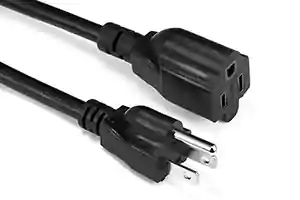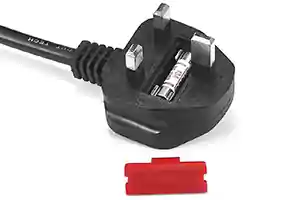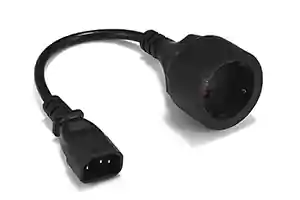For your electrical devices to function properly, they must be plugged into electrical circuits, and this junction is possible thanks to the electrical outlets.
There are different electrical outlets, and DCpowercord presents them to you in this article.

Table of Contents
Male and female electrical sockets: what are the differences?
A first distinction is necessary within the family of electrical outlets, and a distinction is made between male and female sockets.
Female sockets
They distribute or relay the electric current. Materially, they consist of a wall base, insulating materials, two holes, and, sometimes, a protective conductor. This takes the form of a short metal rod.
Male sockets
You will also find them under the name “files.” They consist of an insulating material and two rods made of brass or nickel. They also consist of a hole that allows the male plug to fit into the female socket, and the pressure conductor of the latter fits it in the hole of the male plug.
What electrical sockets are used in France?
It is a nomenclature starting with the letter A and ending with the letter N, making it possible to distinguish the different sockets used in the world. In France, we use type C, E, and F sockets.
Type C sockets
This model without earth connection constitutes the European standard. Two rods make up this type of plug. There are two “models,” depending on the device’s power requirement you want to connect.
Thus, low-power devices require a CEE 7/16 type socket, while more demanding equipment will require CEE 7/17 type sockets.
Note that these two outlets are compatible with type E and F electrical outlets.
Sockets type E and F
These models with earth connection constitute the other European standard. Some type E and F wall outlets have a metal flap.
Electrical outlets: surface-mounted or recessed?
Once the distinction is made between male and female sockets, and type C, E, and F sockets, a further distinction can be made between surface-mounted sockets and recessed sockets. These exist for the different types of electrical outlets.
The protruding sockets
They are effortless to install; they are the preferred outlets during renovations or simply adding an outlet to an already existing circuit. You do not need to drill a hole in your wall to embed the socket or the bulkhead to pass the conductors.
To make the connection, all you have to do is pass the wires or the cable through trunking (this is an exposed sheath). The socket box is then to be hung directly on the wall, and the connection is made in the housing.
Surface-mounted sockets comply with the directives of standard NF C 15-100 in terms of electrical safety.
Recessed sockets
The advantage of recessed sockets is that they are completely “hidden” in the wall. They, therefore, offer a greater aesthetic advantage than protruding sockets.
That said, expect a bit longer and more “complicated” jobs. Indeed, it will be necessary to proceed to the bleeding in the support, to ensure the passage of the sheaths and the wires, to proceed with the sealings, to the refilling, probably to redo the painting or the wallpaper, …
If you buy a new home, know that you will only have recessed sockets. All the connections are made inside a single box. The socket plate is also supported on this box. This plate is the only visible part of a recessed socket.
The recessed sockets also meet the directives of standard NF C 15-100 in terms of electrical safety, provided they are properly installed.
Electrical outlets: indoor or outdoor?
An electrical outlet will not guarantee similar protections depending on whether it performs its function indoors or outdoors (protection against shocks, against water, dust, to protect against accidental contact, etc.).

The interior electrical outlet
Inside your home, outlets are a definite source of danger. For this reason, child safety devices are now made compulsory by standard NF C 15-100.
You may have noticed that the boxes and plates of your power outlets are made of plastic, which significantly reduces the risk of impacts, mechanical dangers, or even crushing.
No standard requires the installation of watertight outlets in a home. Of course, care must be taken to follow the regulations in force for water features in the bathroom, and it will protect you against the risk of splashes or projections.
Keep in mind that if you add an outlet in your bathroom, it must be fixed more than 2 feet from your shower or bathtub. You will also need to provide a differential device with a caliber of 30 mA. Finally, the earth conductor of your home must be connected to all visible metal parts.
Install electrical outlets elsewhere in your home must be at least 5 cm from the ground, and their intensity is 16 A. An installation at least 12 cm from the floor is recommended for particular sockets, such as oven sockets.
Note that electrical outlets always have protective equipment, such as a fuse or circuit breaker.
The external electrical outlet
The external electrical outlet must be fixed at least 1m from the ground. It must display an IP protection index of at least a value equal to 25.
Most often, for obvious security reasons, you may observe removable flaps on this type of socket. Seals will also be present to prevent dust and water from entering the housing.
The protection index here amounts to 55, which offers the best guarantees against dust and splashing water.
To guard against the mechanical risks mentioned above, you can equip yourself with electrical outlets fitted with a metal casing. They display an IP of 66 or 67.
Do not forget to connect this external socket to the earth!
Other types of electrical outlets
When we talk about an electrical outlet, we always think of the outlet that brings us the electric current. But there are also other types of electrical outlets.
The audio/video socket allows you to connect a television, a projector, or even speakers.
The programmer has a clock used to program the power supply times and the cut-off times for the various equipment in the house.
The USB socket is used to recharge the battery of devices fitted with this socket type.
The TV, satellite, and FM socket are often connected to an aerial socket and allow the audio source or audio and video to be reproduced.
The RJ 45 socket is used to deliver a network signal, and this is what we use to benefit from ADSL, for example.
The telephone socket is used, as its name suggests, to connect a (landline) telephone. It tends to disappear with the advent of “all-digital.”
The bathroom shaver socket is the only one that can deviate from the safety distance of 60 cm from a shower or a bathtub. It is fitted with a separate transformer to make electrocution and electrification impossible. For information, know that this type of socket previously had a power of 12 V only, and today, thanks to the isolation transformer, it has a power of up to 230 V.
What types of outlets are in the world?
When you travel abroad, you sometimes need to take an adapter with you, allowing you to connect to the electrical network regardless of its voltage. In all, there are 14 different types of plugs in the world. This is explained by the type of electrical network, its voltage, or even the protection standards of each country or “group” of countries.
Here is a summary table for the different countries:
| Types of sockets | Specificities of the catch | Country |
| Type A | 2 pins Without earth Amps: 15 A Volts: 100 - 127 V | United States, Japan, Canada and Mexico |
| Type B | 3 pins One pin with earth Amps: 15 A Volts: 100 - 127 V | United States, Japan, Canada and Mexico |
| Type C | 2 pins Without earth Amps: 2.5 A Volts: 220 - 240 V | Europe, Asia and South America |
| Type D | 3 pins One pin with earth Amps: 5 A Volts: 220 - 240 V | Inde |
| Type E | 2 pins The earth constitutes the female socket Amps: 16 A Volts: 220 - 240 V | France, Belgium, Poland, Czech Republic and Slovakia |
| Type F | 2 pins Without earth Amps: 16 A Volts: 220 - 240 V | Europe (except UK and Ireland) and Russia |
| Type G | 3 pins Without earth Amps: 13 A Voltage: 220 - 240 V | United Kingdom, Ireland, Malaysia, Singapore and Malta |
| Type H | 3 pins One with earth Amps: 16 A Volts: 220 - 240V | Israel, West Bank and Gaza Strip |
| Type I | 2 or 3 pins 2 pins: without earth or 3 pins with 1 earth | Australia, New Zealand, China and Argentina |
| Type J | 3 pins One with earth Amps: 10 A Volts: 220 - 240 V | Switzerland, Rwanda and Liechtenstein |
| Type K | 3 pins One with earth Amps: 16 A Volts: 220 - 240 V | Denmark and Greenland |
| Type L | 3 pins One central pin with earth Amps: 10 A and 16 A Volts: 220 - 240 V | Italy and Chile |
| Type M | 3 pins One pin with earth Amps: 15 A Volts: 220 - 240 V | South Africa |
| Type N | 3 pins One central pin with earth Amps: 10 A and 20 A Volts: 220 - 240 V | Brazil |




